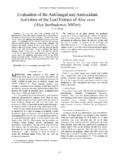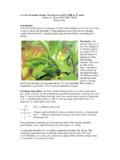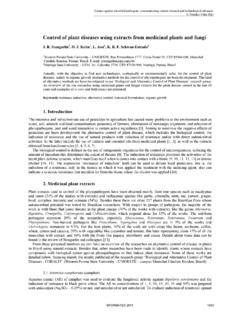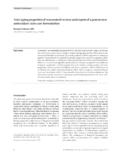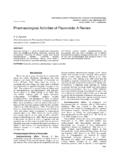Transcription of Phenolics in Human Health - IJCEA
1 Abstract Recent research focuses on Health benefits of phytochemicals, especially antioxidant and antimicrobial properties of phenolic compounds, which is known to exert preventive activity against infectious and degenerative diseases, inflammation and allergies via antioxidant, antimicrobial and proteins/enzymes neutralization/modulation mechanisms. Phenolic compounds are reactive metabolites in a wide range of plant-derived foods and mainly divided in four groups: phenolic acids, flavonoids, stilbenes and tannins. They work as terminators of free radicals and chelators of metal ions that are capable of catalyzing lipid oxidation. Therefore, this review examines the functional properties of Phenolics . Index Terms Health , functional, phenolic compounds. I. INTRODUCTION In recent years, fruits and vegetables receive considerable interest depending on type, number, and mode of action of the different components, so called as phytochemicals , for their presumed role in the prevention of various chronic diseases including cancers and cardiovascular diseases.
2 Plants are rich sources of functional dietary micronutrients, fibers and phytochemicals, such as ascorbic acid, carotenoids, and phenolic compounds, that individually, or in combination, may be beneficial for Health since they demonstrate antioxidative activity in vitro [1] [4]. Phenolics , possess an aromatic ring bearing one or more hydroxyl groups and their structures may range from that of a simple phenolic molecule to that of a complex high-molecular weight polymer, are widespread groups of substances in flowering plants, occurring in all vegetative organs, as well as in flowers and fruits, vegetables, cereals, grains, seeds and drinks. Despite this structural diversity, the groups of compounds are often referred to as polyphenols . They are secondary metabolites which are derived from pentose phosphate, shikimate, and phenylpropanoid pathways in plants [5] [7].
3 Plant genetics and cultivar, soil composition and growing conditions, maturity state and post-harvest conditions are effective on the quantity and quality of the polyphenols present in plant foods [8]. Phenolic compounds can basically be categorized into several classes as shown in Fig. 1. Aside with being responsible for the color (such as yellow, orange, red, and blue pigments), taste and flavor (such as vanillin and eugenol) of foods one of the major polyphenol characteristics is radical-scavenging capacity, which is involved in antioxidant properties, and the ability to interact Manuscript received November 20, 2013; revised February 21, 2014. The authors are with Department of Food Engineering, Faculty of Agriculture, Uludag University, Bursa, Turkey (e-mail: with proteins. The high antioxidant capacity makes polyphenols as an important key factor which is involved in the chemical defense of plants against pathogens and predators and in plant-plant interferences [9].)
4 Fig. 1. Main classes of polyphenolic compounds. A. Phenolic Acids Phenolic acids consist of two subgroups: the hydroxybenzoic and hydroxycinnamic acids include gallic, p-hydroxybenzoic, protocatechuic, vanillic and syringic acids, which in common have the C6 C1 structure. Hydroxycinnamic acids, on the other hand, are aromatic compounds with a three-carbon side chain (C6 C3), with caffeic, ferulic, p-coumaric and sinapic acids being the most common. The main sources of phenolic acids are blueberry, cranberry, pear, cherry (sweet), apple, orange, grapefruit, cherry juice, apple juice, lemon, peach, potato, lettuce, spinach, coffee beans, tea, coffee and cider. Hydroxycinnamic acids are a major class within the phenolic compounds [10], [11]. B. Flavonoids Flavonoids are the most abundant polyphenols in Human diets, accounting for over half of the eight thousand naturally occurring phenolic compounds found mainly in blackberries, black currant, blueberries, grape, strawberries, cherries, plums, cranberry, pomegranate, and raspberry.
5 They are low molecular weight compounds, consisting of fifteen carbon atoms; bear the C6 C3 C6 structure. They are mainly divided into two classes: (a) anthocyanins (glycosylated derivative of anthocyanidin, present in colorful flowers and fruits); (b) anthoxanthins (a group of colorless compounds further T. Ozcan, A. Akpinar-Bayizit, L. Yilmaz-Ersan, and B. Delikanli Phenolics in Human Health International Journal of Chemical Engineering and Applications, Vol. 5, No. 5, October 2014393 DOI: divided in several categories, including flavones, flavans, flavonols, isoflavones and their glycosides) [10], [12] [14]. C. Tannins Tannins, the relatively high molecular weight compounds found in complexes with alkaloids, polysaccharides and proteins, are a group of water-soluble polyphenols. They may be subdivided into hydrolysable and condensedtannins. The hydrolysable tannins are esters ofgallic acid (gallo- and ellagi-tannins), while the condensed tannins(also known as proanthocyanidins) are polymers of polyhydroxyflavan-3-ol monomers.
6 A third subdivision, the phlorotannins consisting entirely of phloroglucinol, has been isolated from several genera of brown algae. They are found grape (dark/light) seed/skin, apple juice, strawberries, raspberries, pomegranate, walnuts, muscadine grape, peach, blackberry, olive, plum, chick pea, black-eyed peas, lentils, haricot bean, red/white wine, cocoa, chocolate, tea, cider, coffee, immature fruits are the main sources of tannins [10] [15]. D. Stilbenes Stilbenes are structurally characterized by the presence of a 1,2-diphenylethylene nucleus with hydroxyl groups substitued on the aromatic rings. They exist in the form of monomers or oligomers. The best known compound is trans-resveratrol, possessing a trihydroxystilbene skelelton [16]. The major dietary sources of stilbenes include grapes, wine, soy, peanuts, and peanut products [17].
7 II. POLYPHENOLS IN Health The possible Health benefits of dietary Phenolics depend on their absorption and metabolism, which in turn are determined by their structure including their conjugation with other Phenolics , degree of glycosilation/acylation, molecular size and solubility. These steps occur at various points during passage through the wall of the small intestine into the circulatory system and subsequent transport to the liver in the portal vein. The metabolites of polyphenols are rapidly eliminated from plasma, thus, daily consumption of plant products is essential in order to supply high metabolite concentrations in the blood [18] [21]. However, one should keep in mind that the most abundant polyphenols in daily diet are not necessarily those that have the best bioavailability. For example hydroxycinnamic acids are found at high concentrations in foods but esterification decreases their intestinal absorption.
8 The bioavailability of phenolic compounds can also be affected by differences in cell wall structures, location of glycosides in cells and binding of phenolic compounds within the food matrix [22] [26]. Upto now epidemiological knowledge emphasize that polyphenols display important functions, like inhibition of pathogens and decay microorganisms, anti-deposition of triglycerides, reduce the incidence of non-communicable diseases such as cardiovascular diseases, diabetes, cancer and stroke, anti-inflammation and anti-allergic effect through processes involving reactive oxygen species. These protective effects are attributed, in part, to phenolic secondary metabolites [26] [28]. Initially, the protective effect of dietary Phenolics was thought to be due to their antioxidant properties which are the lowering of the levels of free radicals present in the body.
9 However, there is now emerging evidence that the metabolites of dietary Phenolics , which appear in the circulatory system in nmol/L to low mmol/L concentrations, exert modulatory effects in cells through selective actions on different components of the intracellular signaling cascades vital for cellular functions such as growth, proliferation and apoptosis [18]. Polyphenols is thought to display their antioxidant capacity, depending on the hydroxylation status of their aromatic rings, including (i) scavenging of free radicals, (ii) chelation and stabilization of divalent cations, and (iii) modulation of endogenous antioxidant enzymes [29] [31]. Phenolic acids, hydrolysable tannins, and flavonoids have anti-carcinogenic and anti-mutagenic effects since they act as protective agents of DNA against free radicals, by inactivating carcinogens, inhibiting enzymes involved in pro-carcinogen activation and by activating of xenobiotics detoxification enzymes.
10 In particular flavonoids and L-ascorbic acid have a synergistic protective effect towards oxidative damages of DNA in lymphocytes [32] [34]. Block et al. [35] stated that a diet rich in vegetables reduces the risk for colon cancer. Both chlorogenic and caffeic acids are antioxidants in vitro, and they are potential inhibitors for the formation of mutagenic and carcinogenic N-nitroso compounds in vitro [36]. Flavonoids, catechins and their derivatives are considered as therapeutic agents in studies focused on degenerative diseases and brain aging processes, and serve as possible neuroprotective agents in progressive neurodegenerative disorders such as Parkinson's and Alzheimer's diseases [37] [40]. High flavonoid intakes lead a decrease in LDL oxidation [41], [42]. Resveratrol, trans-3,5,4 -trihydroxystilbene, is the best known Health promoting molecule in grapes and red wine, and has been studied for its effects on genes as well as the heart, breast, prostate, uterus, and immune system.







